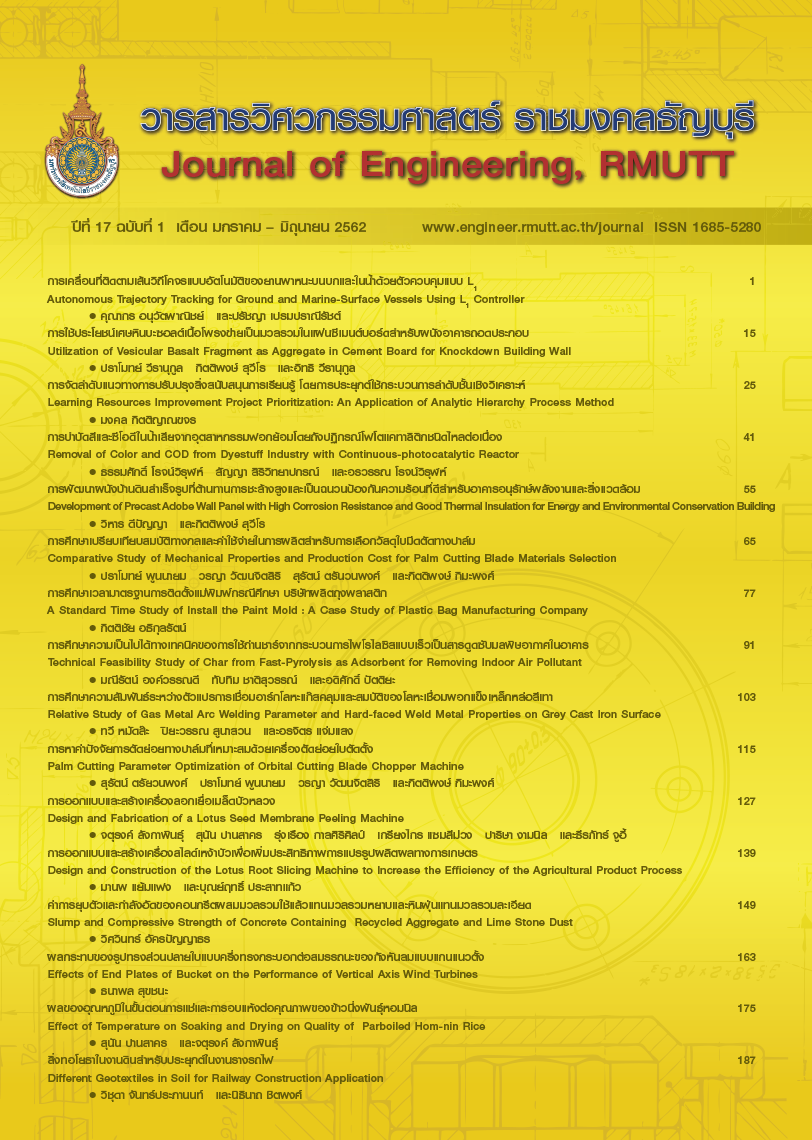Effect of Temperature on Soaking and Drying on Quality of Parboiled Hom-nin Rice
Main Article Content
Abstract
The objective of research was to investigate the effect of temperature (30, 40oC) on the immersion process of rice in water and temperature (40, 80oC) in the drying step to the quality of parboiled Hom-nin rice. Color values (L*,a*,b*), total color difference (DE*), moisture content and the amount of anthocyanin were investigated. The results showed that no statistically significant differences (P>0.05) in color value (L*,a*,b*) of the Hom-nin rice kernel before and after the production of parboiled rice. However, find out the total color difference reduction trend when increasing the temperature of the soaked rice seed from 30oC to 40oC at 4 hr and drying of parboiled Hom-nin rice with temperature 40oC and 80oC. By the dehumidification of parboiled Hom-nin rice kernel was show the moisture content value between 11.33-13.57%wb. and water activity (aw) between 0.5-0.6. It is suitable for dry food products as it extends the shelf life. In addition, when detecting the amount of anthocyanin of Hom-nin rice was presented 5.11 mg/g dry weight. But, after rice is soaked in water and drying at higher temperatures from parboiling process found that the amount of anthocyanin just left between 3.03-4.33 mg/g dry weight. However, the production process of parboiled rice is to improve rice quality and it can be stored longer than the storage in the form of brown rice.
Article Details
The manuscript, information, content, picture and so forth which were published on Frontiers in engineering innovation research has been a copyright of this journal only. There is not allow anyone or any organize to duplicate all content or some document for unethical publication.
References
Leethanapanich K, Mauromoustakos A, Y.J. Wang Y.J. Impacts of parboiling conditions on quality characteristics of parboiled commingled rice. Journal of Cereal Science. 2016; 69: 283–289.
Paiva F. F, Vanier N. L. V, Berrios J. J, Pinto V. Z, Wood D, Williams T. Elias M.C. Polishing and parboiling effect on the nutritional and technological properties of pigmented rice. Food Chemistry. 2016; 191: 105–112.
Sarangapani C, Thirumdas R, Devi Y, Trimukhe A, Deshmukh R. R, Annapure U.S. Effect of low-pressure plasma on physicoechemical and functional properties of parboiled rice flour. LWT - Food Science and Technology. 2016; 69: 482–489.
Bhattacharya K. R. Parboiling of rice. In E. T. Champagne (Ed.), Rice: Chemistry and technology. St. Paul, MN, USA: American Association of Cereal Chemists; 2004. p. 289-348.
Delcour, J. A. Hoseney R.C. Rice and oat processing. Principles of Cereal Science and Technology. St. Paul, MN, USA: AACC International; 2010. p. 149-160.
Buggenhout J, Brijs K, Celus I, Delcour J.A. The breakage susceptibility of raw and parboiled rice: a review. Journal of Food Engineering. 2013; 117: 304-315.
Kar N, Jain R.K, Srivastaya P.P. Parboiling of de husked rice. Journal of Food Engineering. 1999; 39(1): 17-22.
Soponronnarit S, Nathakaranakule A, Jirajindalert A, Taechapairoj C. Parboiling brown rice using superheated steam fluidization technique. 2006; Journal of Food Engineering. 2006; 75(3): 423-432.
Parnsakhorn S, Noomhorm A. Changes in Physicochemical Properties of Parboiled Brown Rice during Heat Treatment. Agricultural Engineering International: the CIGR E-journal. Manuscript FP 08 009. Vol. X. 2008.
Buggenhout J, Brijs K, Oevelen J.V, Delcour J.A. Milling breakage susceptibility and mechanical properties of parboiled brown rice kernels. Food Science and Technology. 2014; 59(1): 369-375.
Laze M.C, Savio M, Pizzala R, Cazzalini O, Perucca P, Scovassi A.I, Stivala L.A, Bianchi L. Anthocyanins induce cell cycle perturbations and apoptosis in different human celllines. Carcinogenesis. 2004; 25(8): 1427-1433.
AOAC. Official Methods of Analyses of the Association of Official Analytical Chemists. 15th ed. Association of Official Analytical Chemists. 1990.
Rhim R. V, Nunes V. A, Jones K, Swartzel R. Kinetics of color change of grape juice generated using linearly increasing temperature. Journal of Food Science. 1989; 54(3): 776–777.
Suwan N. Effect of coating materials on controlling of browning and weight loss in lychee fruit. Master of Science in Biology. Chiang Mai University. 2005. (in Thai)
Ranganna S. Plant pigment. In S. Ragana (ed.). Manual of analysis of fruit and vegetable produce. Tata McGraw-Hill Publishing Co., Ltd, New Delhi; 1977. p. 72-93.
Sompong R, Siebenhandl-Ehn S, Linsberger-Martin G. Berhhofer E. Physicochemical and antioxidative properties of red and black rice varieties from Thailand, China and Srilanka. Food Chemistry. 2011; 124(1): 132-140.
Lee J.C, Kim J.D, Hsieh F.H, Eun J.B. Production of black rice cake using ground black rice and medium-grain brown rice. International Journal of Food Science and Technology. 2008; 43(6): 1078-1082.
Singhasurasak H, Rice berry. 2014 [cited 2014 May 25]. Available from: http://riceberry- rice.blogspot.com/2013/12/blog-post.html. (in Thai)
Pillaiyar P, Mohandas R. Hardness and color in parboiled rice produced at low and high temperature. Journal of Food Science and Technology. 1981; 18: 7-9.
Kimura T, Bhattacharya K.R, Ali S.Z. Discoloration characteristics of rice during parboiling (I): Effect of processing conditions on the color intensity of parboiled rice. Journal of the Society of Agricultural Structures. 1993; 24(2): 23–30.
Parnsakhorn S. Thermal process. 2nd ed. Bangkok: Triple Education Co., Ltd.; 2017. (in Thai)
Das A, Das S, Subudhi H, Mishra P, Sharma S. Extension of shelf life of brown rice with some traditionally available materials. Indian Journal of Traditional Knowledge. 2012; 11(3): 553-555.
Parnsakhorn S. Thermal process. 2nd ed. Bangkok: Triple Education Co., Ltd.; 2017.
Rungsardthong V. Food processing technology. 5th ed. Bangkok: Text and Journal Publication Co., Ltd.; 2014. (in Thai)
Markakis P. Anthocyanins as food colors. New York : Academic Press. 1982.


